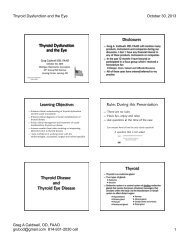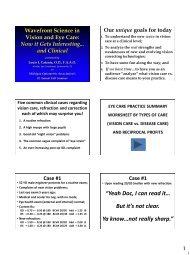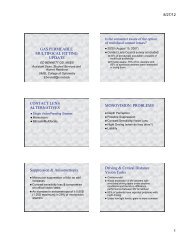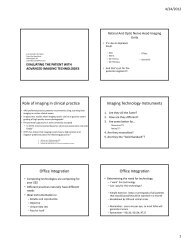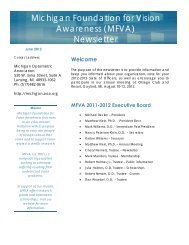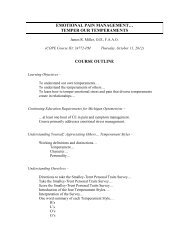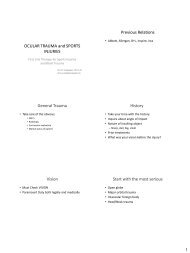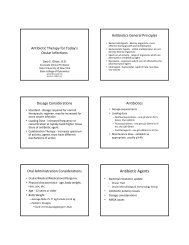Clinical Medicine and Technology Trends - Michigan Optometric ...
Clinical Medicine and Technology Trends - Michigan Optometric ...
Clinical Medicine and Technology Trends - Michigan Optometric ...
Create successful ePaper yourself
Turn your PDF publications into a flip-book with our unique Google optimized e-Paper software.
<strong>Clinical</strong> <strong>Medicine</strong> <strong>and</strong> <strong>Technology</strong> <strong>Trends</strong><br />
In Primary Eye Care<br />
<strong>Clinical</strong><br />
<strong>Medicine</strong><br />
<strong>and</strong><br />
<strong>Technology</strong><br />
<strong>Trends</strong><br />
In Primary Eye Care<br />
Presented for the<br />
<strong>Michigan</strong> <strong>Optometric</strong> Association<br />
Phone: (901) 357-0371<br />
Correspondence<br />
David K. Talley, O.D.<br />
West Tennessee Eye<br />
2070 Whitney Avenue<br />
Memphis, TN 38127<br />
Fax: (901) 358-7574<br />
E-mail: westtennesseeeye@bellsouth.net<br />
12/1/2009 David K. Talley O.D., F.A.A.O. 3<br />
Commercial Disclosure<br />
• The content of this course was prepared<br />
independently by Dr. Talley without input<br />
from members of the ophthalmic industry.<br />
• Dr. Talley has no direct financial or<br />
proprietary interest in any companies,<br />
products or services mentioned in this<br />
presentation.<br />
12/1/2009 David K. Talley, O.D., F.A.A.O.<br />
5<br />
David K. Talley, O.D., F.A.A.O.<br />
Private Practitioner<br />
Managing Partner,<br />
Special Projects<br />
Memphis, Tennessee<br />
Millington, Tennessee<br />
Brighton, Tennessee<br />
12/1/2009 David K. Talley O.D., F.A.A.O. 2<br />
Course Description<br />
This course presents developments in science<br />
<strong>and</strong> medicine that will change Optometry.<br />
Specific topics to be discussed are:<br />
The Genomic Revolution, Radio Frequency<br />
Therapy, Tissue Engineering <strong>and</strong> Biomechanics,<br />
Anesthetic Alternatives, Angiogenesis Inhibition,<br />
Wavefront Technologies, Beyond Phaco <strong>and</strong><br />
Sedative Optometry<br />
12/1/2009 David K. Talley O.D., F.A.A.O. 4<br />
The Genomic Revolution<br />
• Molecular<br />
Optometry<br />
• The Human<br />
Genome<br />
Project<br />
• Gene Chip<br />
<strong>Technology</strong><br />
• Anti – Sense<br />
Drugs<br />
12/1/2009 David K. Talley O.D., F.A.A.O. 6<br />
12/1/2009<br />
David K. Talley, O.D., F.A.A.O. 1
<strong>Clinical</strong> <strong>Medicine</strong> <strong>and</strong> <strong>Technology</strong> <strong>Trends</strong><br />
In Primary Eye Care<br />
The Genomic Revolution<br />
Molecular Optometry<br />
• Nearly every ocular disease has a genetic<br />
component<br />
• The Human Genome Project (HGP) was<br />
completed in 2003<br />
12/1/2009 David K. Talley O.D., F.A.A.O. 7 12/1/2009 David K. Talley O.D., F.A.A.O. 8<br />
The Human Genome Project<br />
• Collaborated study between National<br />
Institutes of Health (NIH) <strong>and</strong> the<br />
Department of Energy<br />
• The largest project ever undertaken in<br />
biological medical science<br />
12/1/2009 David K. Talley O.D., F.A.A.O. 9<br />
The Genome Revolution<br />
12/1/2009 David K. Talley O.D., F.A.A.O. 11<br />
Hey Dave….<br />
WHAT IS<br />
THE HUMAN<br />
GENOME<br />
PROJECT?<br />
The Goals of the Human<br />
Genome Project are to:<br />
1. Map the human genome<br />
2. Sequence all human DNA<br />
3. Explore ethical, legal <strong>and</strong> social issues<br />
4. Develop comparative genomics<br />
5. Advance functional genomics<br />
6. All of the above<br />
12/1/2009 David K. Talley O.D., F.A.A.O. 10<br />
The Genome Revolution<br />
Gene Chips<br />
• Affymetrix has developed tiny chip probes<br />
for doing DNA sequence analysis,<br />
genotyping, mutation analysis <strong>and</strong> gene<br />
expression studies<br />
12/1/2009 David K. Talley O.D., F.A.A.O. 12<br />
12/1/2009<br />
David K. Talley, O.D., F.A.A.O. 2
<strong>Clinical</strong> <strong>Medicine</strong> <strong>and</strong> <strong>Technology</strong> <strong>Trends</strong><br />
In Primary Eye Care<br />
The Genome Revolution<br />
Gene Chips<br />
• The Gene Chip Probe<br />
Array contains<br />
miniaturized, high-density<br />
DNA arrays placed on<br />
glass or silicon chips<br />
• Slightly smaller than a<br />
dime<br />
12/1/2009 David K. Talley O.D., F.A.A.O. 13<br />
FACT OR FICTION?<br />
• Gene Chips may be used to diagnose<br />
disease, help find the right drug for a<br />
specific disease variant, screen large<br />
populations for disease patterns <strong>and</strong><br />
detect susceptibility genes<br />
12/1/2009 David K. Talley O.D., F.A.A.O. 15<br />
The Genomic Revolution<br />
Anti-Sense Drugs<br />
• Potentially, these drugs would be more<br />
fast-acting <strong>and</strong> efficient than conventional<br />
medicines with less side effects<br />
• Also, could allow for increased duration<br />
<strong>and</strong> potency with alternative routes of<br />
administration<br />
12/1/2009 David K. Talley O.D., F.A.A.O. 17<br />
The Genome Revolution<br />
Gene Chips<br />
• Target DNA from the<br />
patient is isolated,<br />
labeled, incubated with<br />
the probe array <strong>and</strong><br />
inserted into a scanner<br />
that detects patterns of<br />
hybridization.<br />
12/1/2009 David K. Talley O.D., F.A.A.O. 14<br />
The Genomic Revolution<br />
Anti-Sense Drugs<br />
• Traditional drugs target<br />
disease-causing proteins<br />
• Anti-sense drugs inhibit the<br />
transcription of messenger<br />
RNA making them more<br />
specific <strong>and</strong> selective<br />
12/1/2009 David K. Talley O.D., F.A.A.O. 16<br />
Glaucoma & Genomic <strong>Medicine</strong><br />
• 70 genes, chromosomal<br />
regions containing genes<br />
(ie. loci), <strong>and</strong> alleles that<br />
either cause glaucoma or<br />
are associated with<br />
syndromes encompassing<br />
glaucoma have already<br />
been identified<br />
12/1/2009 David K. Talley O.D., F.A.A.O. 18<br />
12/1/2009<br />
David K. Talley, O.D., F.A.A.O. 3
<strong>Clinical</strong> <strong>Medicine</strong> <strong>and</strong> <strong>Technology</strong> <strong>Trends</strong><br />
In Primary Eye Care<br />
Glaucoma & Genomic <strong>Medicine</strong><br />
What Now? What Next?<br />
• Which risk alleles contribute to the<br />
common forms of glaucoma?<br />
• Do genetic modifiers affect the age of<br />
onset <strong>and</strong> severity of glaucoma?<br />
• Do genetic markers influence the outcome<br />
of glaucoma treatments?<br />
12/1/2009 David K. Talley O.D., F.A.A.O. 19<br />
Ocular Gene Therapy Here?<br />
Leber’s Congenital Amaurosis (LCA)<br />
• Investigators used a viral vector to carry a<br />
normal version of the RPE 65 gene which<br />
was administered by subretinal injection<br />
• By two weeks post-op, all three patients<br />
reported improved vision in the injected<br />
eye (HM to 20/710 <strong>and</strong> less nystagmus)<br />
12/1/2009 David K. Talley O.D., F.A.A.O. 21<br />
Radio Surgery<br />
• Radio Surgery uses high frequent ( 1.7 to<br />
4 MHz) radio waves for tissue transection<br />
• High frequent waves cause the water<br />
molecules to oscillate vaporizing the<br />
intracellular fluid. This forces the<br />
membrane of the cell to burst, separating<br />
the tissue<br />
12/1/2009 David K. Talley O.D., F.A.A.O. 23<br />
Ocular Gene Therapy Here?<br />
Leber’s Congenital Amaurosis (LCA)<br />
• LCA is characterized by a mutation in the<br />
RPE65 gene which prohibits the<br />
development of the Retinal Pigment<br />
Epithelium <strong>and</strong> inhibits the retina from<br />
processing light<br />
• A three patient gene therapy trial on young<br />
adults with LCA was conducted in Engl<strong>and</strong><br />
12/1/2009 David K. Talley O.D., F.A.A.O. 20<br />
Radio Frequency Therapy<br />
• Radio Surgery<br />
(Electrosurgery)<br />
• Capacitive<br />
Radiofrequency<br />
<strong>Technology</strong><br />
(Thermage)<br />
• Conductive<br />
Keratoplasty (CK)<br />
12/1/2009 David K. Talley O.D., F.A.A.O. 22<br />
Radiofrequency <strong>Technology</strong><br />
12/1/2009 David K. Talley O.D., F.A.A.O. 24<br />
12/1/2009<br />
David K. Talley, O.D., F.A.A.O. 4
<strong>Clinical</strong> <strong>Medicine</strong> <strong>and</strong> <strong>Technology</strong> <strong>Trends</strong><br />
In Primary Eye Care<br />
Radio Surgery<br />
Ellman Surgitron Unit<br />
12/1/2009 David K. Talley O.D., F.A.A.O. 25<br />
Radio Surgery<br />
Electrosurgery<br />
A B<br />
A. Electrodesiccation<br />
B. Fulguration<br />
Distinct Waveforms<br />
• Fully rectified – Cut / Coagulation…<br />
cutting with hemostasis, ideal for<br />
subcutaneous tissue dissection,<br />
especially useful in vascular areas<br />
12/1/2009 David K. Talley O.D., F.A.A.O. 27<br />
Radio Surgery<br />
Distinct Waveforms<br />
• Fulguration… maximum penetration <strong>and</strong><br />
hemostasis, ideal for intentional tissue<br />
destruction<br />
12/1/2009 David K. Talley O.D., F.A.A.O. 29<br />
Radio Surgery<br />
Distinct Waveforms<br />
• Fully Filtered – Cut… micro-smooth<br />
cutting, negligible lateral heat, minimal<br />
cellular destruction, ideal for skin incision<br />
<strong>and</strong> biopsy, best cosmetic results, fastest<br />
healing<br />
12/1/2009 David K. Talley O.D., F.A.A.O. 26<br />
Radio Surgery<br />
Distinct Waveforms<br />
• Partially Rectified – Coagulation…<br />
coagulation <strong>and</strong> shrinkage, ideal for<br />
cutting with hemostasis control<br />
12/1/2009 David K. Talley O.D., F.A.A.O. 28<br />
Radio Surgery<br />
Distinct Waveforms<br />
• Bipolar… pinpoint, micro-coagulation, no<br />
tissue adherence to forceps, no charring<br />
or tissue necrosis, ideal for coagulation in<br />
<strong>and</strong> around critical anatomy<br />
12/1/2009 David K. Talley O.D., F.A.A.O. 30<br />
12/1/2009<br />
David K. Talley, O.D., F.A.A.O. 5
<strong>Clinical</strong> <strong>Medicine</strong> <strong>and</strong> <strong>Technology</strong> <strong>Trends</strong><br />
In Primary Eye Care<br />
Radio Surgery in Eye Care<br />
• Resection of benign <strong>and</strong> malignant skin<br />
tumors<br />
• Xanthelasma removal<br />
• Blepharoplasty<br />
• Epilation<br />
• Chalazion incision <strong>and</strong> curettage<br />
12/1/2009 David K. Talley O.D., F.A.A.O. 31<br />
Advantages of Radio Surgery<br />
1. Leading of the instrument without<br />
pressure or tensile<br />
2. Coagulation of small vessels during the<br />
cutting<br />
3. Minor tissue damage<br />
4. Lower cost price compared to laser<br />
technology<br />
5. All of the above<br />
12/1/2009 David K. Talley O.D., F.A.A.O. 33<br />
Capacitive Radiofrequency<br />
• A 6 MHz radiofrequency signal used to<br />
tighten, contour <strong>and</strong> rejuvenate facial skin<br />
to help naturally restore a more youthful<br />
appearance<br />
• This technology tightens existing collagen<br />
<strong>and</strong> stimulate new collagen production<br />
12/1/2009 David K. Talley O.D., F.A.A.O. 35<br />
Radio Surgery in Dermatology<br />
Rhinophmya Pre <strong>and</strong> Post Radio Surgery<br />
12/1/2009 David K. Talley O.D., F.A.A.O. 32<br />
Radio Surgery Vs. Electro Cautery<br />
• Higher frequency of the radio waves<br />
• Faster disintegration of the tissue<br />
• Less lateral heat propagation<br />
• Less thermal tissue damage<br />
• Faster healing<br />
• Minor scar formation<br />
12/1/2009 David K. Talley O.D., F.A.A.O. 34<br />
Capacitive Radiofrequency<br />
Thermal Tip<br />
12/1/2009 David K. Talley O.D., F.A.A.O. 36<br />
12/1/2009<br />
David K. Talley, O.D., F.A.A.O. 6
<strong>Clinical</strong> <strong>Medicine</strong> <strong>and</strong> <strong>Technology</strong> <strong>Trends</strong><br />
In Primary Eye Care<br />
“The Beauty of Thermage”<br />
Before After<br />
Movie Time<br />
12/1/2009 David K. Talley O.D., F.A.A.O. 37<br />
Conductive Keratoplasty<br />
View Point CK System<br />
12/1/2009 David K. Talley O.D., F.A.A.O. 39<br />
Conductive Keratoplasty<br />
Intra Operative<br />
Immediate Post Operative<br />
12/1/2009 David K. Talley O.D., F.A.A.O. 41<br />
Conductive Keratoplasty<br />
• The application of radiofrequency (350<br />
kHz) energy that the cornea converts to<br />
heat in a controlled fashion<br />
• FDA approved for the reduction of<br />
hyperopia (0.75 -3.25D ) <strong>and</strong> the induction<br />
of myopia (-1.00 to -2.00D) to improve<br />
near vision in presbyopic emmetropes /<br />
hyperopes over 40 years of age<br />
12/1/2009 David K. Talley O.D., F.A.A.O. 38<br />
Conductive Keratoplasty<br />
Ring pattern applied<br />
in peripheral corneal<br />
Increase in central<br />
corneal curvature<br />
12/1/2009 David K. Talley O.D., F.A.A.O. 40<br />
Post LASIK CK Successful…<br />
• FDA ongoing clinical trial: CKafterLASIK.com<br />
• Trial sites as follows:<br />
Stephen G. Slade, M.D., Houston TX<br />
Ralph Chu, M.D., Minneapolis, MN<br />
Daniel S. Durrie, M.D., Overl<strong>and</strong> Park, KS<br />
Michael Gordon, M.D., San Diego, CA<br />
Peter S. Hersh, M.D., Teaneck, NJ<br />
12/1/2009 David K. Talley O.D., F.A.A.O. 42<br />
12/1/2009<br />
David K. Talley, O.D., F.A.A.O. 7
<strong>Clinical</strong> <strong>Medicine</strong> <strong>and</strong> <strong>Technology</strong> <strong>Trends</strong><br />
In Primary Eye Care<br />
CK After LASIK Early Results<br />
• Accuracy <strong>and</strong> efficiency of CK on post<br />
LASIK patients is higher than the original<br />
CK approved data<br />
• Binocularly, 100% of patients achieved<br />
visual acuity of 20/25 or better at distance<br />
<strong>and</strong> 91% achieve J2 or better at near<br />
12/1/2009 David K. Talley O.D., F.A.A.O. 43<br />
Tissue Engineering & Biomechanics<br />
Ocular Regeneration<br />
• Combines elements of engineering <strong>and</strong><br />
material science with genetic, molecular,<br />
cell <strong>and</strong> developmental biology<br />
• Organ replacement <strong>and</strong> regeneration<br />
12/1/2009 David K. Talley O.D., F.A.A.O. 45<br />
Tissue Engineering & Biomechanics<br />
Ocular Regeneration<br />
• Engineered corneas could replace<br />
conventional transplants in 10 years<br />
• Advantages include no rejection, no tissue<br />
supply problems <strong>and</strong> no iatrogenic disease<br />
transmission<br />
12/1/2009 David K. Talley O.D., F.A.A.O. 47<br />
Tissue Engineering & Biomechanics<br />
• Organ regeneration<br />
<strong>and</strong> replacement<br />
• Ocular regeneration<br />
• Biomechanics<br />
• Wound Healing<br />
• Tissue Adhesives<br />
12/1/2009 David K. Talley O.D., F.A.A.O. 44<br />
Tissue Engineering & Biomechanics<br />
Ocular Regeneration<br />
• Engineered replacement tissue constructs<br />
are already in development for a variety of<br />
tissues<br />
• Skin, cartilage, nerve, liver, kidney,<br />
muscle, heart valves, blood vessels <strong>and</strong><br />
cornea<br />
12/1/2009 David K. Talley O.D., F.A.A.O. 46<br />
Tissue Engineering & Biomechanics<br />
Ocular Regeneration ?<br />
• Immediate applications include toxicity <strong>and</strong><br />
drug efficacy testing, thus reducing the<br />
use of animals<br />
12/1/2009 David K. Talley O.D., F.A.A.O. 48<br />
12/1/2009<br />
David K. Talley, O.D., F.A.A.O. 8
<strong>Clinical</strong> <strong>Medicine</strong> <strong>and</strong> <strong>Technology</strong> <strong>Trends</strong><br />
In Primary Eye Care<br />
Biomechanics & Wound Healing<br />
• Key to achieving the most from refractive<br />
surgery is an underst<strong>and</strong>ing of the<br />
biomechanics of the refractive procedures<br />
in the eye coupled with advances in<br />
pharmaceuticals to facilitate wound<br />
healing<br />
• Wavefront technology is ahead of the<br />
biology<br />
12/1/2009 David K. Talley O.D., F.A.A.O. 49<br />
Biomechanics & Wound Healing<br />
• Can be used to seal a<br />
clear corneal cataract<br />
incision<br />
• Laser-activated<br />
biodendrimer<br />
adhesive can be used<br />
to seal a LASIK flap<br />
12/1/2009 David K. Talley O.D., F.A.A.O. 51<br />
Wound Closure w/ Tissue Adhesive<br />
Laceration Dermabond<br />
Immediate Postop 10 Day Postop<br />
12/1/2009 David K. Talley O.D., F.A.A.O. 53<br />
Biomechanics & Wound Healing<br />
• Clear biodendrimer<br />
glue (Hyperbranch<br />
Medical <strong>Technology</strong><br />
Inc., Raleigh, N.C.<br />
• Laser activated <strong>and</strong><br />
self-gelling polymer<br />
• Design to heal corneal<br />
wounds<br />
12/1/2009 David K. Talley O.D., F.A.A.O. 50<br />
Biomechanics & Wound Healing<br />
“With the imminent burgeoning of phakic<br />
<strong>and</strong> pseudoaccommodative IOL’s, this<br />
new glue will offer a safe, effective <strong>and</strong><br />
innovative alternative to suturing or leaving<br />
the corneal wound to self-seal”<br />
Terry Kim, M.D., Associate Professor of<br />
Ophthalmology, Duke University Eye Center<br />
12/1/2009 David K. Talley O.D., F.A.A.O. 52<br />
Advantages of Tissue Adhesives<br />
• Incisions can be<br />
closed 3 x faster<br />
• Less need for<br />
anesthesia<br />
• No stitches to<br />
remove<br />
• Seals out most<br />
common bacteria<br />
• May shower or bathe<br />
• Disappears naturally<br />
as wound heals<br />
• Less need for<br />
b<strong>and</strong>ages<br />
• More comfortable<br />
than stitches<br />
12/1/2009 David K. Talley O.D., F.A.A.O. 54<br />
12/1/2009<br />
David K. Talley, O.D., F.A.A.O. 9
<strong>Clinical</strong> <strong>Medicine</strong> <strong>and</strong> <strong>Technology</strong> <strong>Trends</strong><br />
In Primary Eye Care<br />
Disadvantages of Tissue Adhesives<br />
• Wound must have<br />
straight edges<br />
• Wound cannot be<br />
stretched or pulled<br />
• Wound edges must<br />
have good<br />
apposition<br />
• Cannot be used on<br />
cornea or conjunctival<br />
tissue<br />
• Expires faster than<br />
sutures<br />
• Expensive… $24 per<br />
single use vial<br />
12/1/2009 David K. Talley O.D., F.A.A.O. 55<br />
All minor surgical procedures of<br />
the eye <strong>and</strong> adnexa can be<br />
performed using only topically<br />
applied anesthetics<br />
1. True<br />
2. False<br />
12/1/2009 David K. Talley O.D., F.A.A.O. 57<br />
Anesthesia Alternatives<br />
12/1/2009 David K. Talley O.D., F.A.A.O. 59<br />
Dermabond Application<br />
• Apply using two thin<br />
layers using a light<br />
brushing stroke while<br />
holding wound together<br />
• Flexible bond in 45 –60<br />
seconds <strong>and</strong> full strength<br />
in 2½ minutes<br />
Watch <strong>and</strong> Learn<br />
12/1/2009 David K. Talley O.D., F.A.A.O. 56<br />
Anesthetic Alternatives<br />
• Cetacaine<br />
Spray<br />
• Xylocaine<br />
Solution<br />
• Iontophoresis<br />
• Lidocaine with<br />
liposomes<br />
12/1/2009 David K. Talley O.D., F.A.A.O. 58<br />
Papilloma Profile in Pictures<br />
• 58 YO AA F presents w/ a bump of 3 month<br />
duration. No pain, but getting bigger. GEE<br />
done by OD partner 1 week prior, completely<br />
unremarkable except for refractive error.<br />
12/1/2009 David K. Talley O.D., F.A.A.O. 60<br />
12/1/2009<br />
David K. Talley, O.D., F.A.A.O. 10
<strong>Clinical</strong> <strong>Medicine</strong> <strong>and</strong> <strong>Technology</strong> <strong>Trends</strong><br />
In Primary Eye Care<br />
Papilloma Profile in Pictures<br />
Lesion Characteristics:<br />
A → + Asymmetry (lobules)<br />
B → + Borders (smooth) / - Bleeding<br />
C → + Color (flesh) / - Care (previous)<br />
D → + Diameter (10 mm) / + Duration (3 months)<br />
E → + Evaluate (wide base @ conjunctiva)<br />
12/1/2009 David K. Talley O.D., F.A.A.O. 61<br />
Papilloma Progress in Pictures<br />
Remove Lesion Cauterize Wound Immediate PO<br />
• Don’t forget to send tissue out to path lab<br />
• Dx: Vercucca / Squamous Papilloma w/ an abundant<br />
scale crust<br />
12/1/2009 David K. Talley O.D., F.A.A.O. 63<br />
Entropion Repair – Post Op<br />
Immediate Post Op 2 Week Post Op<br />
12/1/2009 David K. Talley O.D., F.A.A.O. 65<br />
Papilloma Progress in Pictures<br />
Topical Cetacaine in Action<br />
• Don’t forget to<br />
administer<br />
proparacaine &<br />
Celluvisc<br />
12/1/2009 David K. Talley O.D., F.A.A.O. 62<br />
Entropion Repair – Sx Summary<br />
• Cautery punctures are<br />
applied horizontally<br />
resulting in tissue<br />
shrinkage <strong>and</strong> contraction<br />
• Puncture sites are<br />
approximately 2-3mm<br />
deep <strong>and</strong> apart<br />
12/1/2009 David K. Talley O.D., F.A.A.O. 64<br />
Entropion Repair – Step by Step<br />
+ =<br />
Prepare disposable<br />
cautery unit<br />
while anesthesia is<br />
being administered<br />
12/1/2009 David K. Talley O.D., F.A.A.O. 66<br />
12/1/2009<br />
David K. Talley, O.D., F.A.A.O. 11<br />
→
<strong>Clinical</strong> <strong>Medicine</strong> <strong>and</strong> <strong>Technology</strong> <strong>Trends</strong><br />
In Primary Eye Care<br />
Entropion Repair – Movie Magic<br />
• Cautery punctures are<br />
applied 2-3 mm from<br />
the lid margin spaced<br />
horizontally resulting in<br />
immediate contraction<br />
of the tissue<br />
12/1/2009 David K. Talley O.D., F.A.A.O. 67<br />
ELA – Max Topical Anesthetic<br />
• 4% - 40mg lidocaine<br />
per g (OTC)<br />
• Uses encapsulated<br />
liposomes<br />
• $48.00 per 30g tube<br />
• Use with or without<br />
occlusive dressing<br />
12/1/2009 David K. Talley O.D., F.A.A.O. 69<br />
Literature Update<br />
“ELA – Max topically applied 30 minutes<br />
before IV sedation is as effective as<br />
injected buffered lidocaine in reducing<br />
pain”<br />
Luhmann J, Hurt S, Shootman M, et al: A comparison of<br />
buffered lidocaine versus ela-max before peripheral<br />
intravenous catheter insertion in children. In: Pediatrics<br />
2004 Mar; 113(3): 217-20<br />
12/1/2009 David K. Talley O.D., F.A.A.O. 71<br />
Entropion Repair – Movie Magic<br />
• Immediate<br />
improvement in<br />
entropion post repair<br />
with forced closure<br />
12/1/2009 David K. Talley O.D., F.A.A.O. 68<br />
Literature Update<br />
“ELA – Max topically applied 30 minutes<br />
before IV sedation is as effective as<br />
injected buffered lidocaine in reducing<br />
pain”<br />
1. True<br />
2. False<br />
12/1/2009 David K. Talley O.D., F.A.A.O. 70<br />
Angiogenesis Inhibition<br />
• The process of angiogenesis can be<br />
helpful such as in wound healing or<br />
harmful as in PDR or AMD<br />
• Vascular Endothelial Growth Factor<br />
(VEGF) is a critical mediator in stimulating<br />
the formation of new, <strong>and</strong> “leaky”, blood<br />
vessels<br />
12/1/2009 David K. Talley O.D., F.A.A.O. 72<br />
12/1/2009<br />
David K. Talley, O.D., F.A.A.O. 12
<strong>Clinical</strong> <strong>Medicine</strong> <strong>and</strong> <strong>Technology</strong> <strong>Trends</strong><br />
In Primary Eye Care<br />
Angiogenesis Inhibition<br />
VEGF is implicated in:<br />
• Neovascular AMD (WAMD)<br />
• Diabetic Retinopathy (DR)<br />
• Retinal Vein Occlusion (RVO)<br />
• Retinopathy of Prematurity (ROP)<br />
• Corneal Neovascularization (KNV)<br />
• Iris Neovacularization (INV)<br />
• Neovascular Glaucoma (NVG)<br />
12/1/2009 David K. Talley O.D., F.A.A.O. 73<br />
Lucentis Vs. Avastin<br />
• Cancer <strong>and</strong> ophthalmic drugs have<br />
different manufacturing st<strong>and</strong>ards.<br />
• Particulate matter must be very low in<br />
intravitreal ophthalmic drugs, <strong>and</strong> Avastin<br />
is not manufactured in this manner<br />
• Keeping Avastin sterile when splitting the<br />
quantity for treatment might be a problem<br />
because it does not contain preservatives<br />
12/1/2009 David K. Talley O.D., F.A.A.O.<br />
75<br />
Lucentis Vs. Avastin<br />
• Avastin is a longer molecule that can<br />
cause increased inflammation<br />
• Lucentis is a smaller molecule that can<br />
penetrate the retina easier with less<br />
inflammation<br />
• The National Eye Institute has announced<br />
a multicenter study that will compare<br />
Lucentis to Avastin directly<br />
12/1/2009 David K. Talley O.D., F.A.A.O.<br />
77<br />
Angiogenesis Inhibition<br />
$1950.00 $550.00<br />
• Lucentis <strong>and</strong> Avastin bind to VEGF<br />
causing inactivation <strong>and</strong> the breakdown<br />
of angiogenesis<br />
12/1/2009 David K. Talley O.D., F.A.A.O.<br />
74<br />
Lucentis Vs. Avastin<br />
• Pre-clinical trial toxicity data for Avastin<br />
does not exist in retinal therapy<br />
• The half-life of Avastin clears 100 times<br />
slower than Lucentis – at this time, it is<br />
unknown if this is harmful<br />
• Lucentis binds to VEGF more strongly<br />
than Avastin – this binding blocks blood<br />
vessel growth<br />
12/1/2009 David K. Talley O.D., F.A.A.O.<br />
76<br />
Lucentis Vs. Avastin<br />
Lucentis Avastin<br />
MCA MCA*<br />
$2029.40 for drug N/A<br />
$169.18 for injection $169.18 for injection<br />
Total = $2198.58 Total = $169.18<br />
*Cahaba Medicare 2009 will pay only when Macugen or PDT has failed to<br />
control wet AMD. Medicare will pay for the injection, but not the medication.<br />
12/1/2009 David K. Talley O.D., F.A.A.O.<br />
78<br />
12/1/2009<br />
David K. Talley, O.D., F.A.A.O. 13
<strong>Clinical</strong> <strong>Medicine</strong> <strong>and</strong> <strong>Technology</strong> <strong>Trends</strong><br />
In Primary Eye Care<br />
Intravitreal Injection Technique<br />
• Patient<br />
preparation with<br />
betadine <strong>and</strong><br />
lidocaine jelly<br />
12/1/2009 David K. Talley O.D., F.A.A.O.<br />
79<br />
Intravitreal Injection Technique<br />
• Injection site is placed<br />
3.5 to 4 mm inferior<br />
temporal or inferior<br />
nasal to the limbus<br />
through the sclera into<br />
the vitreous behind the<br />
lens with a 30 G, 0.5<br />
inch needle<br />
12/1/2009 David K. Talley O.D., F.A.A.O.<br />
81<br />
Post Vitreal Injection Guidelines<br />
• Cover with topical<br />
antibiotics for one<br />
week<br />
• One week<br />
reevaluation for<br />
possible<br />
complications<br />
12/1/2009 David K. Talley O.D., F.A.A.O.<br />
83<br />
Intravitreal Injection Technique<br />
12/1/2009 David K. Talley O.D., F.A.A.O.<br />
80<br />
Intravitreal Injection Technique<br />
• BIO is performed<br />
looking for<br />
retina/vitreous<br />
hemorrhages <strong>and</strong><br />
optic nerve<br />
perfusion<br />
immediately<br />
following the<br />
procedure<br />
12/1/2009 David K. Talley O.D., F.A.A.O.<br />
82<br />
Intravitral Injection Complications<br />
• Mild <strong>and</strong> common complications<br />
– Conjunctival hemorrhage<br />
– Retinal hemorrhage<br />
– Vitreous detachment <strong>and</strong> floaters<br />
– Pain <strong>and</strong> irritation<br />
– Foreign body sensation with increased<br />
tearing<br />
12/1/2009 David K. Talley O.D., F.A.A.O.<br />
84<br />
12/1/2009<br />
David K. Talley, O.D., F.A.A.O. 14
<strong>Clinical</strong> <strong>Medicine</strong> <strong>and</strong> <strong>Technology</strong> <strong>Trends</strong><br />
In Primary Eye Care<br />
Intravitreal Injection Complications<br />
• Severe but rare complications<br />
– Thromboembolism<br />
– Inflammation <strong>and</strong> increased intraocular<br />
pressure<br />
– CVA<br />
– Endophthalmitis<br />
– Cataract<br />
– Retinal detachment<br />
12/1/2009 David K. Talley O.D., F.A.A.O.<br />
85<br />
Ocular Iontophoresis<br />
Transscleral Iontophoresis Delivery Platform<br />
12/1/2009 David K. Talley O.D., F.A.A.O. 87<br />
EyeGate II Advantage<br />
• Non-invasive delivery to anterior <strong>and</strong><br />
posterior chambers of the eye<br />
• Programmable dose control<br />
• Average delivery time is 3 – 5minutes<br />
• Increased patient safety <strong>and</strong> potential for<br />
lower cost of care<br />
12/1/2009 David K. Talley O.D., F.A.A.O. 89<br />
I would perform Intravitreal<br />
Injection for the treatment of<br />
ocular disease if properly trained<br />
<strong>and</strong> licensed.<br />
1. Yes<br />
2. No<br />
3. Maybe<br />
12/1/2009 David K. Talley O.D., F.A.A.O.<br />
86<br />
EyeGate II Delivery System<br />
Loading Platform Applying Platform<br />
12/1/2009 David K. Talley O.D., F.A.A.O. 88<br />
I would perform Transscleral<br />
Iontophoresis (EyeGate Delivery<br />
System) for the treatment of<br />
ocular disease if properly trained<br />
<strong>and</strong> licensed.<br />
1. Yes<br />
2. No<br />
3. Maybe<br />
12/1/2009 David K. Talley O.D., F.A.A.O.<br />
90<br />
12/1/2009<br />
David K. Talley, O.D., F.A.A.O. 15
<strong>Clinical</strong> <strong>Medicine</strong> <strong>and</strong> <strong>Technology</strong> <strong>Trends</strong><br />
In Primary Eye Care<br />
TargeGen Eye Drops (TG100801)<br />
• First topically prodrug applied<br />
multitargeted VEGF receptor inhibitor<br />
• Under development for the treatment of<br />
Age-Related Macular Degeneration<br />
(AMD), Diabetic Macular Edema (DME),<br />
<strong>and</strong> Diabetic Retinopathy (DR)<br />
12/1/2009 David K. Talley O.D., F.A.A.O. 91<br />
Wavefront <strong>Technology</strong><br />
• Wavefront guided<br />
ablation<br />
• Wavefront guided<br />
refractions <strong>and</strong><br />
prescriptions<br />
• Wavefront guided<br />
IOL design<br />
• Bioptics<br />
12/1/2009 David K. Talley O.D., F.A.A.O. 93<br />
Wavefront-Guided Ablation<br />
• Multifocal ablations are option for<br />
correcting presbyopia?<br />
• Algorithms exist <strong>and</strong> are being refined for<br />
the hyperopic <strong>and</strong> myopic presbyopic<br />
population<br />
• This evolving technology is called<br />
PresbyLASIK<br />
12/1/2009 David K. Talley O.D., F.A.A.O. 95<br />
I would Rx TargeGen Eye Drops<br />
(TG100801) for the treatment of<br />
ocular disease if properly trained<br />
<strong>and</strong> licensed.<br />
1. Yes<br />
2. No<br />
3. Maybe<br />
12/1/2009 David K. Talley O.D., F.A.A.O.<br />
92<br />
Is Wavefront-Guided LASIK<br />
better than conventional LASIK?<br />
1. Custom LASIK results with fewer higher<br />
order aberrations than conventional<br />
LASIK<br />
2. Custom LASIK has improved contrast<br />
sensitivity <strong>and</strong> improvement in glare<br />
3. All of the above are true<br />
12/1/2009 David K. Talley O.D., F.A.A.O. 94<br />
4 th Generation<br />
Intralase FS Laser<br />
Faster <strong>and</strong> Smarter<br />
12/1/2009 David K. Talley O.D., F.A.A.O. 96<br />
12/1/2009<br />
David K. Talley, O.D., F.A.A.O. 16
<strong>Clinical</strong> <strong>Medicine</strong> <strong>and</strong> <strong>Technology</strong> <strong>Trends</strong><br />
In Primary Eye Care<br />
New Intralase is Much Faster<br />
12/1/2009 David K. Talley O.D., F.A.A.O. 97<br />
Intralase – Enabled Keratoplasty<br />
Customized Incisions w/ Advanced Edges<br />
Mushroom Top - Hat Zig - Zag<br />
Preserves more<br />
host endothelium<br />
Allows for the transplantation<br />
of large<br />
endothelial surfaces<br />
Provides a smooth<br />
transition between<br />
host & donor tissue<br />
12/1/2009 David K. Talley O.D., F.A.A.O. 99<br />
Intralase Enabled Keratoplasty (IEK)<br />
Reduction of Induced Astigmatism<br />
Zig Zag Incision IEK 3 month PO Trephine 1 yr PO<br />
Smooth corneal<br />
contour after sx<br />
0.5 diopter of<br />
astigmatism<br />
8.0 diopters of<br />
astigmatism<br />
12/1/2009 David K. Talley O.D., F.A.A.O. 101<br />
Can the IntraLase femtosecond<br />
laser (IntraLase Corp) produce a<br />
more accurate flap than a<br />
conventional microkeratome?<br />
1. Yes<br />
2. No<br />
12/1/2009 David K. Talley O.D., F.A.A.O. 98<br />
Intralase Enabled Keratoplasty (IEK)<br />
Secure Grafts Requiring Less Suture<br />
1 week PO 3 month PO 6 month PO<br />
IEK incisions create less irritation, form hermetic<br />
wound seals, <strong>and</strong> produce clear corneas<br />
12/1/2009 David K. Talley O.D., F.A.A.O. 100<br />
Femtosecond’s Future?<br />
• Design a custom<br />
flap matched to the<br />
patient’s cornea?<br />
• Save more of the<br />
anterior stroma<br />
<strong>and</strong> spare more of<br />
the mid-periphery?<br />
• Reduce dry eye?<br />
• Minimize pain <strong>and</strong><br />
haze?<br />
• Enhance reinnervation<br />
• Produce topographically<br />
<strong>and</strong> biomechanically<br />
stable corneas?<br />
12/1/2009 David K. Talley O.D., F.A.A.O. 102<br />
12/1/2009<br />
David K. Talley, O.D., F.A.A.O. 17
<strong>Clinical</strong> <strong>Medicine</strong> <strong>and</strong> <strong>Technology</strong> <strong>Trends</strong><br />
In Primary Eye Care<br />
• Sub-Bowman’s<br />
Keratomileusis (SBK)<br />
combines the<br />
advantages of LASIK<br />
<strong>and</strong> PRK<br />
• Uses femtosecond<br />
laser to create a<br />
smaller <strong>and</strong> thinner<br />
(110 micron) flap<br />
Intralase SBK<br />
• Damages fewer<br />
cornea nerve endings<br />
which promotes Dry<br />
Eye Syndrome<br />
• Damages fewer<br />
cornea fibers that<br />
help the cornea<br />
maintain its proper<br />
shape<br />
12/1/2009 David K. Talley O.D., F.A.A.O. 103<br />
Wavefront-Guided Prescriptions<br />
• Convention refractions<br />
correct only 2 nd order<br />
aberrations<br />
• The Z-ViewTM<br />
Aberrometer<br />
(Ophthonix) measures<br />
both 2 nd order <strong>and</strong> 3 rd -<br />
6 th order aberrations<br />
12/1/2009 David K. Talley O.D., F.A.A.O. 105<br />
Electronic Lens <strong>Technology</strong><br />
• Micro-electronic controls, which are located in<br />
the temple of a conventional frame, to<br />
automatically adjust add power.<br />
12/1/2009 David K. Talley O.D., F.A.A.O. 107<br />
Are Microkeratomes Dead?<br />
The Moria One Use-Plus<br />
microkeratome with<br />
disposable, single-use<br />
components is safe,<br />
effective <strong>and</strong> reliable for<br />
creating flaps in thin-flap<br />
(SBK) LASIK, <strong>and</strong> it<br />
provides excellent<br />
outcomes at a lower cost<br />
than femtosecond lasers.<br />
12/1/2009 David K. Talley O.D., F.A.A.O. 104<br />
Wavefront-Guided Prescriptions<br />
12/1/2009 David K. Talley O.D., F.A.A.O. 106<br />
Electronic Lens <strong>Technology</strong><br />
• Features a thin layer of liquid crystals<br />
s<strong>and</strong>wiched between two layers of<br />
transparent electrodes.<br />
• The crystal molecules rotate in response<br />
to a mechanical change in voltage, which<br />
alters the index of refraction.<br />
• Under development by Pixel Optics.<br />
12/1/2009 David K. Talley O.D., F.A.A.O. 108<br />
12/1/2009<br />
David K. Talley, O.D., F.A.A.O. 18
<strong>Clinical</strong> <strong>Medicine</strong> <strong>and</strong> <strong>Technology</strong> <strong>Trends</strong><br />
In Primary Eye Care<br />
Wavefront-Guided IOL Design<br />
• AMO Tecnis lens aims to<br />
neutralize the positive<br />
spherical aberration of the<br />
cornea with negative spherical<br />
aberration in the IOL<br />
• Diffractive optics allows for an<br />
even distribution of distant<br />
<strong>and</strong> near images of light with<br />
minority interference<br />
Monofocal<br />
12/1/2009 David K. Talley O.D., F.A.A.O. 109<br />
Bioptics: LASIK Plus?<br />
• Combining Phakic IOLs <strong>and</strong> LASIK<br />
• Extremely useful in patients with myopia<br />
greater than –20D<br />
• Implant IOL followed by wavefront-guided<br />
ablation<br />
12/1/2009 David K. Talley O.D., F.A.A.O. 111<br />
Phakic IOLs: Verisyse<br />
• Correction of Myopia<br />
(-5 to -20D) w/<br />
≤ 2.5 D of astigmatism<br />
• Adults (21-45 YO) w/<br />
ACD ≥ 3.20mm <strong>and</strong> a<br />
stable MR (≤ 0.5D) for 6<br />
months before implantation<br />
12/1/2009 David K. Talley O.D., F.A.A.O. 113<br />
Wavefront-Guided IOL Design<br />
•AMO TECNIS reduces<br />
spherical aberration <strong>and</strong><br />
improves night driving<br />
performance<br />
360° square edge<br />
• Square edge for uninterrupted<br />
contact at the haptic-optic<br />
junction<br />
• Frosted edge designed to<br />
minimize unwanted edge glare Frosted edge<br />
12/1/2009 David K. Talley, O.D., F.A.A.O. 110<br />
Phakic IOLs: Visian ICL<br />
• Correction of Myopia<br />
(-3 to -15D) OR<br />
Reduction of Myopia<br />
(-15 to -20D) w/<br />
≤ 2.5 D of astigmatism<br />
• Adults (21-45 YO) w/ ACD ≥ 3.00mm <strong>and</strong><br />
a stable MR (≤ 0.5D) for 1 year before<br />
implantation<br />
12/1/2009 David K. Talley O.D., F.A.A.O. 112<br />
Nanotechnology Corneal Inlays<br />
• The ACI 7000 (AcuFocus) is a<br />
nanotechnology corneal inlay (3.8mm<br />
diameter) that is inserted under a LASIK<br />
flap in the center of the visual axis of the<br />
non-dominant eye to help improve reading<br />
ability in presbyopes<br />
• It increases depth of focus through 1.6mm<br />
central opening<br />
12/1/2009 David K. Talley O.D., F.A.A.O. 114<br />
12/1/2009<br />
David K. Talley, O.D., F.A.A.O. 19
<strong>Clinical</strong> <strong>Medicine</strong> <strong>and</strong> <strong>Technology</strong> <strong>Trends</strong><br />
In Primary Eye Care<br />
ACI 7000 (AcuFocus)<br />
Acufocus Vs. Autofocus<br />
12/1/2009 David K. Talley O.D., F.A.A.O. 115<br />
Beyond Phaco<br />
• Multifocal Mania<br />
• Accommodative IOL’s<br />
• Dual–Optic Accommodative IOL’s<br />
• Deformable Accommodating IOL’s<br />
• Light Adjusting Lens’s (LAL) <strong>and</strong> Digital<br />
Light Density Devices (DLDD)<br />
• Vortex Emulsification<br />
12/1/2009 David K. Talley O.D., F.A.A.O. 117<br />
Multifocal Mania?<br />
• AMO ReZoom is a threepiece,<br />
acrylic implant with a<br />
refractive, distance-dominant,<br />
multifocal optic (6mm)<br />
• Delivers better intermediate<br />
focus than the ReSTOR, but<br />
less effective at near<br />
12/1/2009 David K. Talley O.D., F.A.A.O. 119<br />
Curious Corneal Inlays?<br />
• Revision Optic’s Presbylens is a plus lens<br />
to correct for presbyopia<br />
• Biovision’s Invue is a refractive microlens<br />
inlay with an opical layout similar to the<br />
ReSTOR IOL<br />
12/1/2009 David K. Talley O.D., F.A.A.O. 116<br />
Multifocal Mania?<br />
• Alcon AcrySof ReStor is<br />
a pseudoaccommodative<br />
diffractive lens<br />
• Deliver better near visual<br />
acuity with a small pupil<br />
<strong>and</strong> better distance<br />
acuity with a large pupil<br />
12/1/2009 David K. Talley O.D., F.A.A.O. 118<br />
Multifocal Mania?<br />
ReSTOR<br />
clone …<br />
or new<br />
improved<br />
ReZoom?<br />
12/1/2009 David K. Talley, O.D., F.A.A.O. 120<br />
12/1/2009<br />
David K. Talley, O.D., F.A.A.O. 20
<strong>Clinical</strong> <strong>Medicine</strong> <strong>and</strong> <strong>Technology</strong> <strong>Trends</strong><br />
In Primary Eye Care<br />
Accomodative IOL’s<br />
• Crystalens (Bausch & Lomb),<br />
silicone,<br />
• A hinge at the junction of the<br />
modified plate haptic / squarededge<br />
biconvex optic allows for<br />
forward movement during ciliary<br />
muscle contraction<br />
• 1.75 - 2.25 D of accommodation<br />
1 st Generation<br />
12/1/2009 David K. Talley O.D., F.A.A.O. 121<br />
Sometime in the next five years<br />
“you’ll see a rebound away from<br />
multifocal lenses toward<br />
accommodating”…<br />
1. Agree<br />
2. Disagree<br />
12/1/2009 David K. Talley O.D., F.A.A.O. 123<br />
Future Factoid?<br />
• Sometime in the next five years “you’ll see<br />
a rebound away from multifocal lenses<br />
toward accommodating”…<br />
• In 10 years, “there won’t be any multifocal<br />
lenses on the market, only monofocal <strong>and</strong><br />
accommodating”.<br />
Richard L. Lindstrom, M.D., Eye World, August 2007<br />
12/1/2009 David K. Talley O.D., F.A.A.O. 125<br />
Accomodative IOL’s<br />
• The next generation Crystalens<br />
HD was FDA approved on June<br />
30 th , 2008 <strong>and</strong> demonstrates an<br />
increased depth of focus as<br />
compared to the previous AT-50<br />
• UCVA Distance: 20/32 (87%)<br />
UCVA Intermed: 20/20 (80%)<br />
UCVA Near: J1 (55%) & J2 (80%)<br />
4th Generation<br />
12/1/2009 David K. Talley O.D., F.A.A.O. 122<br />
In 10 years, “there won’t be any<br />
multifocal lenses on the market,<br />
only monofocal <strong>and</strong><br />
accommodating”.<br />
1. Agree<br />
2. Disagree<br />
12/1/2009 David K. Talley O.D., F.A.A.O. 124<br />
Visiogen Synchrony<br />
Dual-Optic Accomodating IOL’s<br />
• Dual optic lenses have a pluspowered<br />
optic connected by<br />
flexible haptics to a slightly<br />
posterior placed negative<br />
powered optic<br />
• On accommodation, the<br />
distance between the lenses<br />
exp<strong>and</strong>s resulting in a more<br />
plus powered lens<br />
12/1/2009 David K. Talley O.D., F.A.A.O. 126<br />
12/1/2009<br />
David K. Talley, O.D., F.A.A.O. 21
<strong>Clinical</strong> <strong>Medicine</strong> <strong>and</strong> <strong>Technology</strong> <strong>Trends</strong><br />
In Primary Eye Care<br />
The Nulens<br />
Deformable Accomodating IOL’s<br />
• Accommodates by forcing soft<br />
IOL material through a thick<br />
aperture that has been<br />
modeled after penguin eyes<br />
• There are two materials in the<br />
lens with different refractive<br />
indexes<br />
• Accommodative amplitudes<br />
are 6 – 8 diopters<br />
12/1/2009 David K. Talley O.D., F.A.A.O. 127<br />
Calhoun Vision’s<br />
Light Adjustable Lens (LAL)<br />
Light- Adjusted Intraocular Lenses<br />
allows customized lens correction<br />
12/1/2009 David K. Talley O.D., F.A.A.O. 129<br />
Calhoun Vision’s<br />
Light Adjustable Lens (LAL)<br />
• Auturo Chayet M.D. has implanted LAL’s<br />
in 14 patients with all corrected refractive<br />
amounts less than 0.25 diopters from the<br />
targeted amount at 6 months<br />
postoperatively<br />
Real Results?<br />
12/1/2009 David K. Talley O.D., F.A.A.O. 131<br />
Calhoun Vision’s<br />
Light Adjustable Lens (LAL)<br />
• 1 st IOL that can be<br />
precisely <strong>and</strong> noninvasively<br />
adjusted after<br />
the eye is healed<br />
• The lens material is<br />
photosensitive designed<br />
to respond to a lowintensity<br />
beam of light<br />
12/1/2009 David K. Talley O.D., F.A.A.O. 128<br />
Digital Light Delivery Device<br />
• Carl Zeiss Meditec<br />
manufactures the<br />
DLDD which is a slit<br />
lamp-delivered device<br />
that enable the laser<br />
light to be delivered in<br />
a digital manner in<br />
less than 2 minutes<br />
• Wavefront guided<br />
data can be dialed<br />
into the DLDD<br />
allowing for<br />
correction of residual<br />
astigmatism, myopia<br />
or hyperopia<br />
12/1/2009 David K. Talley O.D., F.A.A.O. 130<br />
Calhoun Vision’s<br />
Light Adjustable Lens (LAL)<br />
• The next generation<br />
LAL will put the UV<br />
enhanced layer to<br />
block ambient UV<br />
light on the posterior<br />
surface of the IOL<br />
12/1/2009 David K. Talley O.D., F.A.A.O. 132<br />
12/1/2009<br />
David K. Talley, O.D., F.A.A.O. 22
<strong>Clinical</strong> <strong>Medicine</strong> <strong>and</strong> <strong>Technology</strong> <strong>Trends</strong><br />
In Primary Eye Care<br />
Photochromic IOL’s<br />
Medennium plans to<br />
introduce a one-piece,<br />
aspheric version of the<br />
Aurium photochromic<br />
intraocular lens to Europe<br />
in late 2009, at which time<br />
it will seek FDA clearance<br />
for U.S. clinical trials<br />
12/1/2009 David K. Talley, O.D., F.A.A.O. 133<br />
Atlantic <strong>Technology</strong><br />
Ventures, Inc. <strong>and</strong><br />
MIT are working on a<br />
patented polymer gel<br />
technology (Injectable<br />
Lens Substitute) to<br />
use with the Avantix<br />
News Flash!<br />
12/1/2009 David K. Talley O.D., F.A.A.O. 135<br />
Examination Under Sedation<br />
1. Utilizes medication to sedate a child prior<br />
to examination.<br />
2. Allows for a more thorough examination<br />
when child is uncooperative.<br />
3. May also be used to help calm or relax<br />
adult patients who are nervous or tense.<br />
4. All of the above<br />
12/1/2009 David K. Talley O.D., F.A.A.O. 137<br />
Vortex Emulsification<br />
Avantix by Bausch <strong>and</strong> Lomb<br />
• A 1-2 mm incision is made in the lens<br />
capsule with a probe<br />
• A propeller type of impeller creates a<br />
vortex which actually spins the cataractous<br />
material <strong>and</strong> evacuates it simultaneously<br />
12/1/2009 David K. Talley O.D., F.A.A.O. 134<br />
Sedative Optometry<br />
• Examination Under<br />
Sedation (EUS)<br />
• Sedative <strong>and</strong><br />
hypnotic agents<br />
• Patient selection <strong>and</strong><br />
counseling<br />
• Dosing <strong>and</strong><br />
Administration<br />
12/1/2009 David K. Talley O.D., F.A.A.O. 136<br />
Light Sedation / Anxiolysis<br />
“The administration of oral medications for<br />
the reduction of anxiety <strong>and</strong> a drug<br />
induced state during which the patient<br />
responds normally to verbal comm<strong>and</strong>s.”<br />
Joint Commission on Accreditation of Health Care<br />
Organizations (JCAHO) <strong>and</strong> the American Society of<br />
Anesthesiologists (ASA)<br />
12/1/2009 David K. Talley O.D., F.A.A.O. 138<br />
12/1/2009<br />
David K. Talley, O.D., F.A.A.O. 23
<strong>Clinical</strong> <strong>Medicine</strong> <strong>and</strong> <strong>Technology</strong> <strong>Trends</strong><br />
In Primary Eye Care<br />
Light Sedation / Anxiolysis<br />
“Although cognitive function <strong>and</strong><br />
coordination may be impaired, ventilatory<br />
<strong>and</strong> cardiovascular functions are<br />
unaffected.”<br />
American Society of Anesthesiologists (ASA)<br />
12/1/2009 David K. Talley O.D., F.A.A.O. 139<br />
Sedative – Hypnotic Agents<br />
Chloral Hydrate<br />
• Different strengths <strong>and</strong> forms: capsules,<br />
syrup <strong>and</strong> suppositories<br />
• Contraindications: hypersensitivity,renal /<br />
liver dysfxn, cardiac dz , gastric disorders<br />
• Cautions: mental depression, drug abuse<br />
hx, porphyria, CNS depressant use<br />
12/1/2009 David K. Talley O.D., F.A.A.O. 141<br />
Sedative – Hypnotic Agents<br />
Chloral Hydrate<br />
• For oral <strong>and</strong> rectal dosage form (capsules,<br />
syrup or suppositories):<br />
50mg per kilogram (kg) (23 mg per pound)<br />
of body weight… 30 to 60 minutes prior to<br />
examination.<br />
12/1/2009 David K. Talley O.D., F.A.A.O. 143<br />
Light Sedation / Anxiolysis<br />
Examples of<br />
drugs<br />
administered<br />
orally that might<br />
be considered:<br />
• Sedative – Hypnotics<br />
• Antihistamines<br />
• Benzodiazepine<br />
• Narcotics<br />
12/1/2009 David K. Talley O.D., F.A.A.O. 140<br />
Sedative – Hypnotic Agents<br />
Chloral Hydrate<br />
• Side Effects are uncommon but include:<br />
skin rash / hives, confusion, hallucinations,<br />
unusual excitement<br />
• Overdose Symptoms: confusion<br />
(continuing), convulsions (seizures),<br />
difficulty in swallowing, drowsiness<br />
(severe), low body temp, stomach pain, etc.<br />
12/1/2009 David K. Talley O.D., F.A.A.O. 142<br />
Hey Dave……<br />
Do I need a<br />
DEA # to use<br />
Chloral Hydrate?<br />
Contact DEA Diversion Control Program’s Web site:<br />
www.deadiversion.usdoj.gov<br />
12/1/2009 David K. Talley O.D., F.A.A.O. 144<br />
12/1/2009<br />
David K. Talley, O.D., F.A.A.O. 24
<strong>Clinical</strong> <strong>Medicine</strong> <strong>and</strong> <strong>Technology</strong> <strong>Trends</strong><br />
In Primary Eye Care<br />
• Can I store<br />
Chloral Hydrate<br />
at work so I can<br />
have it readily<br />
available when I<br />
need it?<br />
DEA Dilemma<br />
YES…But you must<br />
maintain an<br />
inventory of drugs<br />
received, <strong>and</strong><br />
dispensed or<br />
administered.<br />
12/1/2009 David K. Talley O.D., F.A.A.O. 145<br />
Stat Kit 700<br />
Stat Kit or Crash Cart<br />
Banyan<br />
Quarterly Updates<br />
www.statkit.com<br />
Stat Kit 900<br />
12/1/2009 David K. Talley O.D., F.A.A.O. 147<br />
Professional Development<br />
www.emergencyuniversity.com<br />
12/1/2009 David K. Talley O.D., F.A.A.O. 149<br />
Remember…<br />
EUS ≠ EUA<br />
... However you must be<br />
prepared for emergencies<br />
12/1/2009 David K. Talley O.D., F.A.A.O. 146<br />
Oxygen System<br />
• Your Stat Kit or Crash Cart<br />
must have oxygen<br />
delivery equipment.<br />
• Know basic life support<br />
<strong>and</strong> how to intervene in<br />
the event of complications<br />
12/1/2009 David K. Talley O.D., F.A.A.O. 148<br />
Patient Selection<br />
• Infants <strong>and</strong> young children who are ASA<br />
Class I or II qualify for sedation when<br />
diagnostic / therapeutic procedure are<br />
required <strong>and</strong> previous attempts<br />
(unsedated) have been unsuccessful.<br />
12/1/2009 David K. Talley O.D., F.A.A.O. 150<br />
12/1/2009<br />
David K. Talley, O.D., F.A.A.O. 25
<strong>Clinical</strong> <strong>Medicine</strong> <strong>and</strong> <strong>Technology</strong> <strong>Trends</strong><br />
In Primary Eye Care<br />
ASA Physical Status<br />
Classification<br />
• Class I: Normal, healthy patient<br />
• Class II: Patient with mild systemic dz<br />
• Class III: Patient w/ severe systemic dz<br />
• Class IV: Pt w/ syst dz w/ threat to life<br />
• Class V: Pt who is needs sx to survive<br />
• Class VI: Brain-dead pt w/ donor organs<br />
12/1/2009 David K. Talley O.D., F.A.A.O. 151<br />
AGE OF<br />
CHILD<br />
Fasting Protocol<br />
SOLIDS &<br />
NONCLEAR<br />
LIQUIDS<br />
CLEAR<br />
LIQUIDS<br />
< 6 months 4 – 6 hours 2 hours<br />
6 – 36 months 6 hours 2 – 3 hours<br />
> 36 months 6 – 8 hours 2 – 3 hours<br />
12/1/2009 David K. Talley O.D., F.A.A.O. 153<br />
Requirements During Sedation<br />
• Obtain baseline vital signs…Blood<br />
Pressure, Pulse <strong>and</strong> Respiration<br />
• Administer medication ONLY in office by<br />
physician or technician <strong>and</strong> document<br />
time…typically one teaspoon (5ml)<br />
12/1/2009 David K. Talley O.D., F.A.A.O. 155<br />
Presedation Counseling<br />
• Informed consent by parent / legal<br />
guardian<br />
• Parent / legal guardian must be present<br />
before, durring <strong>and</strong> after sedation<br />
• Patient should not drink fluids or eat solid<br />
foods as directed<br />
12/1/2009 David K. Talley O.D., F.A.A.O. 152<br />
Presedation Preparation<br />
• Review of systemic condition w/ PCP<br />
• Choose appropriate sedative agent<br />
• Weigh patient <strong>and</strong> calculate dosage<br />
• Rx / obtain sedative agent<br />
• Schedule EUS appropriately<br />
12/1/2009 David K. Talley O.D., F.A.A.O. 154<br />
Patient Monitoring<br />
• Continuous throughout the procedure by<br />
parent / guardian<br />
• Every 15 minute by physician / technician<br />
• Retake vital signs every 30 minutes<br />
• Also monitor alertness<br />
12/1/2009 David K. Talley O.D., F.A.A.O. 156<br />
12/1/2009<br />
David K. Talley, O.D., F.A.A.O. 26
<strong>Clinical</strong> <strong>Medicine</strong> <strong>and</strong> <strong>Technology</strong> <strong>Trends</strong><br />
In Primary Eye Care<br />
Dosage Dilemma<br />
…If sedation is not adequate 30 minutes<br />
post initial administration, give another<br />
teaspoon (5ml) every 30 minutes until<br />
maximum dose is obtained.<br />
12/1/2009 David K. Talley O.D., F.A.A.O. 157<br />
Patient Discharge<br />
• Written post – discharge instructions are<br />
reviewed w/ parent / guardian<br />
• Include after effects of sedation<br />
• Follow – up appointment if necessary<br />
• Emergency Service 24 / 7 protocol<br />
12/1/2009 David K. Talley O.D., F.A.A.O. 159<br />
Wild Child … Pre Sedation<br />
12/1/2009 David K. Talley O.D., F.A.A.O. 161<br />
Patient Recovery<br />
• Once examination or procedure is<br />
complete, the patients level of<br />
consciousness <strong>and</strong> vital signs are<br />
recorded<br />
• Patient is discharged to the care of parent<br />
/ guardian when vital signs are stable <strong>and</strong><br />
patient is responsive to stimuli<br />
12/1/2009 David K. Talley O.D., F.A.A.O. 158<br />
• 3 YO AA M<br />
presents for<br />
consultation from<br />
pediatrician<br />
reference possible<br />
eye turn OS since<br />
birth<br />
Wild Child<br />
• Hx – Normal birth<br />
weight, 1 month<br />
premature,<br />
boarderline asthma,<br />
no previous eye<br />
exam<br />
12/1/2009 David K. Talley O.D., F.A.A.O. 160<br />
EUS Calculations<br />
• Weight: 39 pounds<br />
• 2.2 pounds = 1<br />
kilogram<br />
• 39 / 2.2 = 17.73<br />
kilograms<br />
• 50 mg / kg<br />
st<strong>and</strong>ard dosage<br />
12/1/2009 David K. Talley O.D., F.A.A.O. 162<br />
12/1/2009<br />
David K. Talley, O.D., F.A.A.O. 27
<strong>Clinical</strong> <strong>Medicine</strong> <strong>and</strong> <strong>Technology</strong> <strong>Trends</strong><br />
In Primary Eye Care<br />
EUS Calculations<br />
• Chloral Hydrate<br />
Syrup (500 mg / 5ml)<br />
• 886.50 mg x 5 ml =<br />
500 mg (? ml)<br />
• 8.87 ml Syrup given<br />
12/1/2009 David K. Talley O.D., F.A.A.O. 163<br />
Administering the Medication<br />
• Using a 5cc<br />
syringe works<br />
great<br />
• Squirt medication<br />
to back of mouth<br />
12/1/2009 David K. Talley O.D., F.A.A.O. 165<br />
EUS Results<br />
• UCVA 20 / 30 OD & OS on Allen Chart<br />
• No significant refractive error with<br />
cycloplegic retinoscopy<br />
• Pupils <strong>and</strong> EOMs are normal<br />
• Tonopen is 14 mm hg OU<br />
• Biomicroscopy <strong>and</strong> Dilated Fundus<br />
Examinations are normal<br />
12/1/2009 David K. Talley O.D., F.A.A.O. 167<br />
Weight – Based Dosing Software<br />
www.epocrates.com<br />
12/1/2009 David K. Talley O.D., F.A.A.O. 164<br />
Wild Child… Post Sedation<br />
• 5 ml given @ 2:00<br />
pm; vital signs<br />
normal<br />
• Another 3.75 ml<br />
given @ 2:30 pm;<br />
vital signs normal<br />
Chloral Hydrate..<br />
Good Stuff!<br />
Sedation State @ 2:55pm<br />
12/1/2009 David K. Talley O.D., F.A.A.O. 166<br />
EUS Results<br />
• Hirshberg <strong>and</strong> Cover<br />
Test demonstrated<br />
intermittent exotropia<br />
@ distance; eyes are<br />
straight @ near<br />
fixation; no signs of<br />
Duane’s Syndrome<br />
12/1/2009 David K. Talley O.D., F.A.A.O. 168<br />
12/1/2009<br />
David K. Talley, O.D., F.A.A.O. 28
<strong>Clinical</strong> <strong>Medicine</strong> <strong>and</strong> <strong>Technology</strong> <strong>Trends</strong><br />
In Primary Eye Care<br />
Practice Management<br />
Scheduling Appointments<br />
• Recommend morning<br />
• Arrange for technician support<br />
• Consider more time<br />
• Review with check–in / receptionist<br />
12/1/2009 David K. Talley O.D., F.A.A.O. 169<br />
02/05/08<br />
David K. Talley, O.D.,<br />
F.A.A.O.<br />
Thank You!<br />
Questions… E-mail Dave<br />
westtennesseeeye<br />
12/1/2009<br />
David K. Talley, O.D., F.A.A.O. 29<br />
170<br />
bellsouth.net



